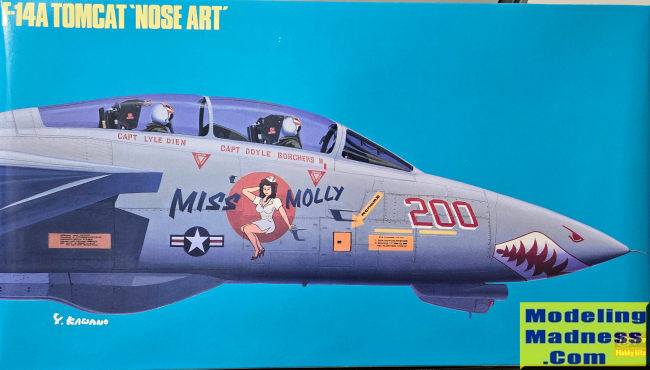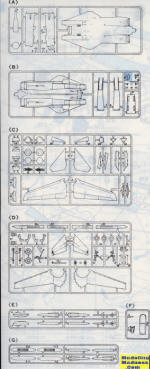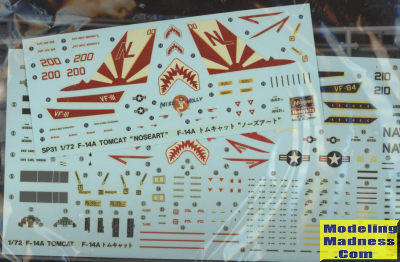
Hasegawa 1/72 F-14A Tomcat 'Nose Art'
| KIT #: | 51531 (SP 31) |
| PRICE: | $1200 yen |
| DECALS: | One option |
| REVIEWER: | Scott Van Aken |
| NOTES: | 1990 release |

| HISTORY |
The history of the Tomcat is well known. Needless to say, it had a long run in operational naval squadrons from its first flight in 1970 until its retirement in 2006, a career of 36 years. About the same length in the USN as the F-4 which first flew in 1958 and was retired in 1987 (though it still lived on as a drone until 2004). Despite being retired from the Navy, it is still being flown by Iran, though who knows how much longer that can go on.
| THE KIT |
 Hasegawa
initially released a Tomcat kit back in 1977, a few years after The F-14 entered
squadron service. This was at the time, the best Tomcat kit in this scale. It
wasn't the first as Monogram had released one several years prior to this, but
it was the best and remained so until they issued their more detailed second
generation F-14 kit in 1988. Even today, this kit is still available and if you
want a less fussy build that includes weapons, then this would be your choice.
So how do you tell the difference between the 1st and 2nd generation kit on the
shelf. Price. The earlier kit will be quite a bit less expensive than the later
version. It will also not be found in dozens of limited edition boxings, as will
the later kit.
Hasegawa
initially released a Tomcat kit back in 1977, a few years after The F-14 entered
squadron service. This was at the time, the best Tomcat kit in this scale. It
wasn't the first as Monogram had released one several years prior to this, but
it was the best and remained so until they issued their more detailed second
generation F-14 kit in 1988. Even today, this kit is still available and if you
want a less fussy build that includes weapons, then this would be your choice.
So how do you tell the difference between the 1st and 2nd generation kit on the
shelf. Price. The earlier kit will be quite a bit less expensive than the later
version. It will also not be found in dozens of limited edition boxings, as will
the later kit.
The kit comes with a cockpit tub of sorts onto which fits a pair of three piece ejection seats. Control columns are provided for both seats (the back seat one is to control the radar) and you get crew members for them. Instrument panels and side consoles use decals. It fits atop the nose gear well. This all fits into the separate nose section. There is no sidewall detail of any kind.
Wings are upper and lower halves and these are geared to interlock with each other so they can swing back and forth. There are holes to open in the lower fuselage for the Phoenix pallets if you wish to install them. Joining the fuselage halves traps the wings so be sure they are in synch before gluing. Intakes include compressor faces and these will fit in the lower fuselage. These items will cause the most difficulty to get in place without gaps or steps so test fit often. The forward wing vanes are also included and you can pose them extended or retracted. I have seen them extended on the ground.
At this time the exhaust is shown being assembled and you have both open and closed burner vanes. I'd leave those off until after painting. The instructions also show you attaching the nose gear to the separate forward section and the landing gear to the main fuselage. Again, I'd leave those off until after painting. The other fit concern is the forward fuselage to the rest so take your time doing this. Instructions show 5 grams of weight required to fit in the radome before attaching that.
 The fins and
tailplanes are net followed by the clear bits. Canopy can be posed open or
closed. The kit provides four Phoenix, two Sparrows, and two Sidewinders to fit
on the various plyons/pallets. A pair of drop tanks are also included.
The fins and
tailplanes are net followed by the clear bits. Canopy can be posed open or
closed. The kit provides four Phoenix, two Sparrows, and two Sidewinders to fit
on the various plyons/pallets. A pair of drop tanks are also included.
Instructions are standard Hasegawa with Gunze paint references. This kit provides the base instructions along with an additional set of decals for the box art plane, 'Miss Molly'. This means that you can build the base VF-111 and VF-84 option as that sheet is included. An addendum sheet provides markings placement for the box art aircraft. All the decal options are in overall gloss light gull grey. Decals themselves are well done though present the usual off white whites that we've come to expect from older Hasegawa kits.
| CONCLUSIONS |
So there you have it. If you want a very nice kit that doesn't 'suffer' from a lot of small parts and inserts, then this or any other first generation Hasegawa F-14A is for you. This one was reboxed by Minicraft when it first came out. A quick google found quite a few priced in the $20 range, which I think is a bit high. You can find these at shows for less.
October 2024
If you would like your product reviewed fairly and fairly quickly, please contact the editor or see other details in the Note to Contributors.